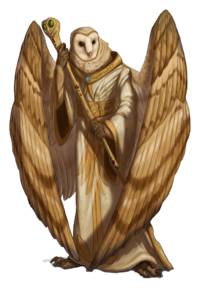- v50 information can now be added to pages in the main namespace. v0.47 information can still be found in the DF2014 namespace. See here for more details on the new versioning policy.
- Use this page to report any issues related to the migration.
Barn owl man
|
b
| |
| Urist likes barn owl men for their coloration. | |
|---|---|
| Portrait | |
| Biome | |
|
| |
| Variations | |
| Attributes | |
| Alignment: | Savage |
| Cannot be tamed | |
| Size | |
| Birth: | 2,115 cm3 |
| Mid: | 17,625 cm3 |
| Max: | 35,250 cm3
|
| Age | |
| Adult at: | 1 |
| Max age: | 60-80 |
| Cannot be butchered | |
v53.06 · v0.47.05 This article is about the current version of DF.Note that some content may still need to be updated. |
- A person with the arms and wings of a barn owl.
Barn owl men are humanoid versions of the common barn owl and a species of unremarkable animal people, found in a wide variety of savage biomes. They are a little over half the size of an adult dwarf and spawn in groups of 5-10 individuals, who are unlikely to pose any danger to your fortress unless provoked. All barn owl men are born with Legendary skill in climbing.
Like other savage animal people, barn owl men may occasionally join civilizations, becoming full-fledged citizens who may appear in your fortress as visitors or be playable in adventurer mode.
Some dwarves like barn owl men for their coloration.

|
This article or section has been rated D for Dwarf. It may include witty humour, not-so-witty humour, bad humour, in-jokes, pop culture references, and references to the Bay12 forums. Don't believe everything you read, and if you miss some of the references, don't worry. It was inevitable. |
Despite some myths and tales told by humans to their young, barn owl men have not been observed to be any wiser than other creatures, though their natural attraction to museums and scholarly careers may lead one to believe such a thing is true, especially when said owls blather on incessantly about whatever artifact is brought up in a conversation.
[CREATURE:BARN_OWL_MAN]
[COPY_TAGS_FROM:BIRD_OWL_BARN]
[APPLY_CREATURE_VARIATION:ANIMAL_PERSON]
[GO_TO_END]
[SELECT_CASTE:MALE]
[CASTE_NAME:barn owl man:barn owl men:barn owl man]
[SELECT_CASTE:FEMALE]
[CASTE_NAME:barn owl woman:barn owl women:barn owl woman]
[SELECT_CASTE:ALL]
[APPLY_CREATURE_VARIATION:PUNCH_ATTACK]
[APPLY_CREATURE_VARIATION:KICK_ATTACK]
[APPLY_CREATURE_VARIATION:TALON_SCRATCH_ATTACK]
[APPLY_CREATURE_VARIATION:BEAK_BITE_ATTACK]
[APPLY_CREATURE_VARIATION:STANDARD_BIPED_GAITS:900:750:600:439:1900:2900] 20 kph
[APPLY_CREATURE_VARIATION:STANDARD_FLYING_GAITS:900:691:482:251:1900:2900] 35 kph
[APPLY_CREATURE_VARIATION:STANDARD_CLIMBING_GAITS:2990:2257:1525:731:4300:6100] 12 kph
[APPLY_CREATURE_VARIATION:STANDARD_SWIMMING_GAITS:2990:2257:1525:731:4300:6100] 12 kph
[APPLY_CREATURE_VARIATION:STANDARD_CRAWLING_GAITS:2990:2257:1525:731:4300:6100] 12 kph
[GO_TO_START]
[NAME:barn owl man:barn owl men:barn owl man]
[DESCRIPTION:A person with the arms and wings of a barn owl.]
[POPULATION_NUMBER:5:10]
[CLUSTER_NUMBER:5:10]
[MAXAGE:60:80]
[CREATURE_TILE:'b']
[COLOR:6:0:0] |

